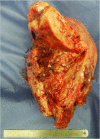Systemic thromboembolism including multiple cerebral infarctions with middle cerebral artery occlusion caused by the progression of adenomyosis with benign gynecological tumor: a case report
- PMID: 33430804
- PMCID: PMC7798234
- DOI: 10.1186/s12883-021-02045-7
Systemic thromboembolism including multiple cerebral infarctions with middle cerebral artery occlusion caused by the progression of adenomyosis with benign gynecological tumor: a case report
Abstract
Background: Adenomyosis, a benign gynecological disease, causes cerebral infarction. Similar to Trousseau's syndrome, it elevates cancer antigen 125 (CA125) and D-dimer levels; causes hypercoagulability; and results in cerebral infarction. However, no case of adenomyosis causing major cerebral artery occlusion and requiring endovascular thrombectomy has yet been reported. We report on a woman with middle cerebral artery occlusion caused by adenomyosis progression with a benign gynecological tumor and recurrent cerebral infarction. She was successfully treated by endovascular thrombectomy and hysterectomy.
Case presentation: A 48-year-old woman with heavy uterine bleeding was transported by ambulance to our hospital. Upon arrival, she presented with impaired consciousness. Laboratory test results revealed decreased hemoglobin (8.2 g/dL) and elevated D-dimer (79.3 µg/mL) levels. Radiological imaging revealed adenomyosis, a left ovarian tumor, multiple uterine myomas, and old and new bilateral renal infarctions. She experienced repeated episodes of excessive menstruation caused by adenomyosis and was scheduled for hysterectomy in 2 months at another hospital. After hospital admission, uterine bleeding stopped. However, 5 days after initial bleeding, she had another episode of heavy uterine bleeding and developed left hemiparesis and dysarthria 20 min later. Brain magnetic resonance imaging revealed bilateral multiple cerebral infarctions indicating right middle cerebral artery occlusion. Thus, endovascular thrombectomy was performed, and anticoagulant therapy was administered. Laboratory test results after thrombectomy revealed elevated CA125 (3536 U/mL) and CA19-9 (892 U/mL) levels. She was at a risk of recurrent heavy uterine bleeding leading to repeated cerebral infarction because of anticoagulant treatment. Therefore, we performed hysterectomy and ovariectomy 11 days after initial bleeding. Histopathological assessment revealed no malignancy. Although she developed asymptomatic pulmonary thromboembolism 14 days after initial bleeding, D-dimer and tumor marker levels returned to normal soon after gynecological surgery. At 15 months post-surgery, she had not experienced further ischemic events.
Conclusions: Adenomyosis with benign gynecological tumors may be associated with elevated D-dimer and tumor marker levels; excessive menstruation; and anemia. It may cause systemic thromboembolism, including cerebral infarction. To our knowledge, no other study has reported that adenomyosis causes major cerebral artery occlusion requiring endovascular thrombectomy. Hysterectomy may be an effective radical treatment of this condition.
Keywords: Adenomyosis; Benign gynecological tumor; Endovascular thrombectomy; Hypercoagulability; Hysterectomy; Middle cerebral artery occlusion; Multiple cerebral infarction; Systemic thromboembolism.
Conflict of interest statement
The authors declare that they have no competing interests.
Figures






Similar articles
-
Multiple Cerebral Infarctions in a Patient with Adenomyosis on Hormone Replacement Therapy: A Case Report.J Stroke Cerebrovasc Dis. 2016 Oct;25(10):e183-4. doi: 10.1016/j.jstrokecerebrovasdis.2016.07.024. Epub 2016 Aug 9. J Stroke Cerebrovasc Dis. 2016. PMID: 27520610
-
"Recurrent multiple cerebral infarctions related to the progression of adenomyosis: a case report".BMC Neurol. 2018 Aug 21;18(1):119. doi: 10.1186/s12883-018-1117-1. BMC Neurol. 2018. PMID: 30129425 Free PMC article.
-
[Anesthetic management of a patient with Trousseau's syndrome and ovarian cancer who underwent gynecological surgery].Masui. 2014 Nov;63(11):1257-60. Masui. 2014. PMID: 25731059 Japanese.
-
Recurrent embolic stroke associated with adenomyosis: A single case report and literature review.Neurol Sci. 2023 Jul;44(7):2421-2429. doi: 10.1007/s10072-023-06701-3. Epub 2023 Feb 23. Neurol Sci. 2023. PMID: 36820990
-
Mechanical Thrombectomy for Middle Cerebral Artery Occlusion Suspected of Ovarian Hyperstimulation Syndrome: Case Report and Review of the Literature.World Neurosurg. 2019 Dec;132:300-302. doi: 10.1016/j.wneu.2019.09.023. Epub 2019 Sep 13. World Neurosurg. 2019. PMID: 31525479 Review.
Cited by
-
Adenomyosis-associated recurrent acute cerebral infarction mimicking Trousseau's syndrome: A case study and review of literature.Surg Neurol Int. 2022 Apr 29;13:179. doi: 10.25259/SNI_252_2022. eCollection 2022. Surg Neurol Int. 2022. PMID: 35509558 Free PMC article.
-
Cerebral venous thrombosis in a patient with adenomyosis: A case report.Clin Case Rep. 2022 Dec 27;10(12):e6796. doi: 10.1002/ccr3.6796. eCollection 2022 Dec. Clin Case Rep. 2022. PMID: 36590670 Free PMC article.
-
Different prophylactic measures for preventing postoperative deep venous thromboembolism in adenomyosis: a retrospective study.Clinics (Sao Paulo). 2025 Jun 14;80:100700. doi: 10.1016/j.clinsp.2025.100700. Online ahead of print. Clinics (Sao Paulo). 2025. PMID: 40517681 Free PMC article.
-
Acute recurrent cerebral infarction caused by moyamoya disease complicated with adenomyosis: A case report.World J Clin Cases. 2022 May 16;10(14):4617-4624. doi: 10.12998/wjcc.v10.i14.4617. World J Clin Cases. 2022. PMID: 35663064 Free PMC article.
-
CA125-Associated Activated Partial Thromboplastin Time and Thrombin Time Decrease in Patients with Adenomyosis.J Multidiscip Healthc. 2024 Jan 16;17:251-261. doi: 10.2147/JMDH.S435365. eCollection 2024. J Multidiscip Healthc. 2024. PMID: 38250313 Free PMC article.
References
-
- Yamashiro K, Tanaka R, Nishioka K, Ueno Y, Shimura H, Okuma Y, et al. Cerebral infarcts associated with adenomyosis among middle-aged women. J Stroke Cerebrovasc Dis. 2012;21:910.e1-5. - PubMed
Publication types
MeSH terms
Substances
LinkOut - more resources
Full Text Sources
Other Literature Sources
Research Materials
Miscellaneous

